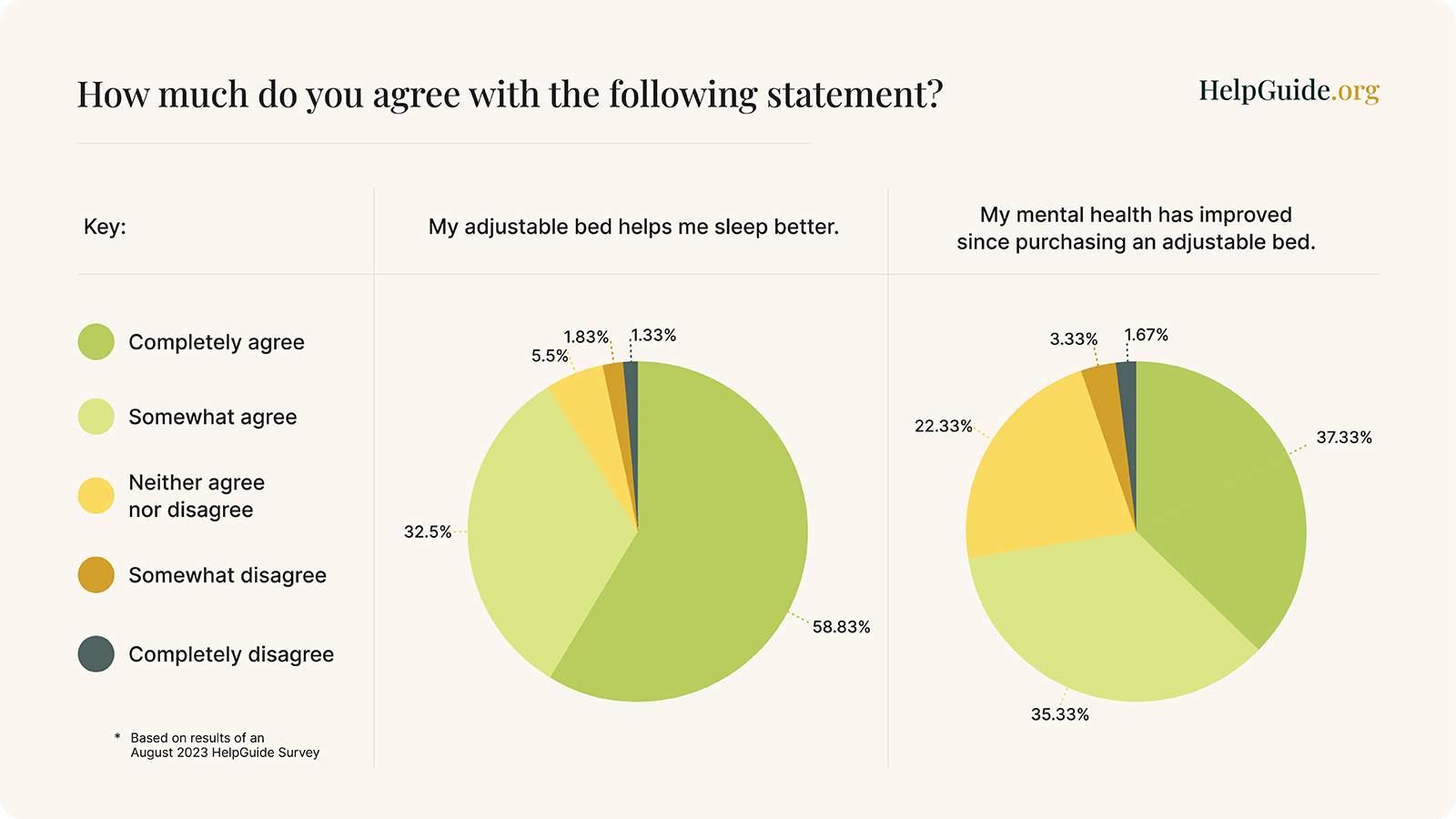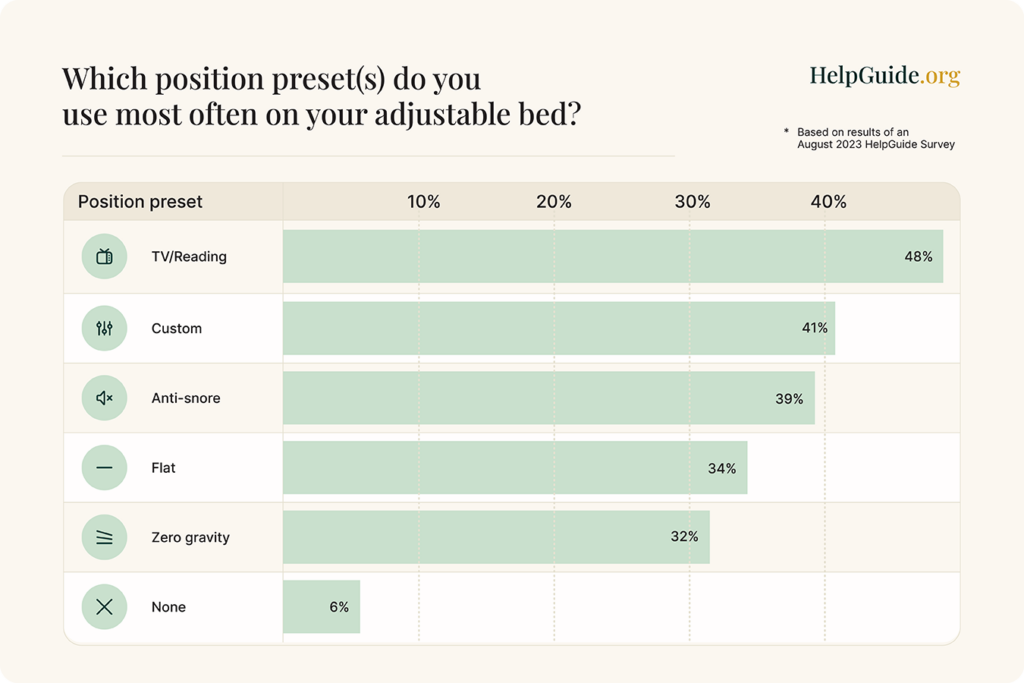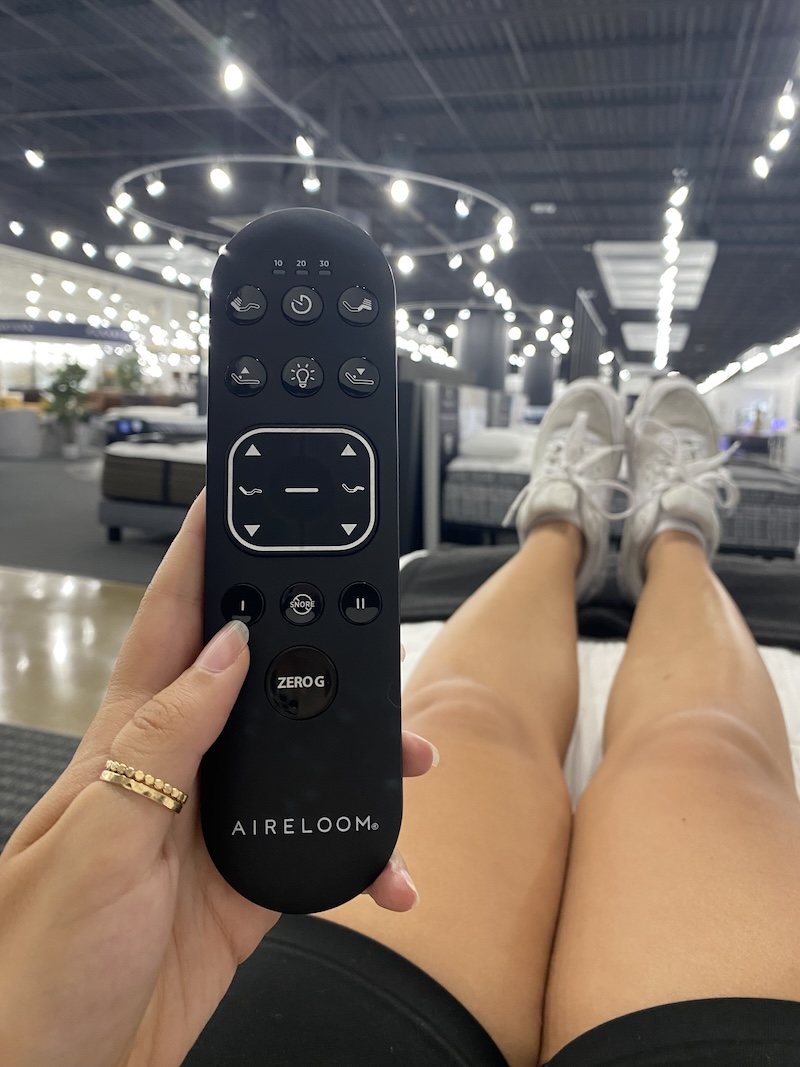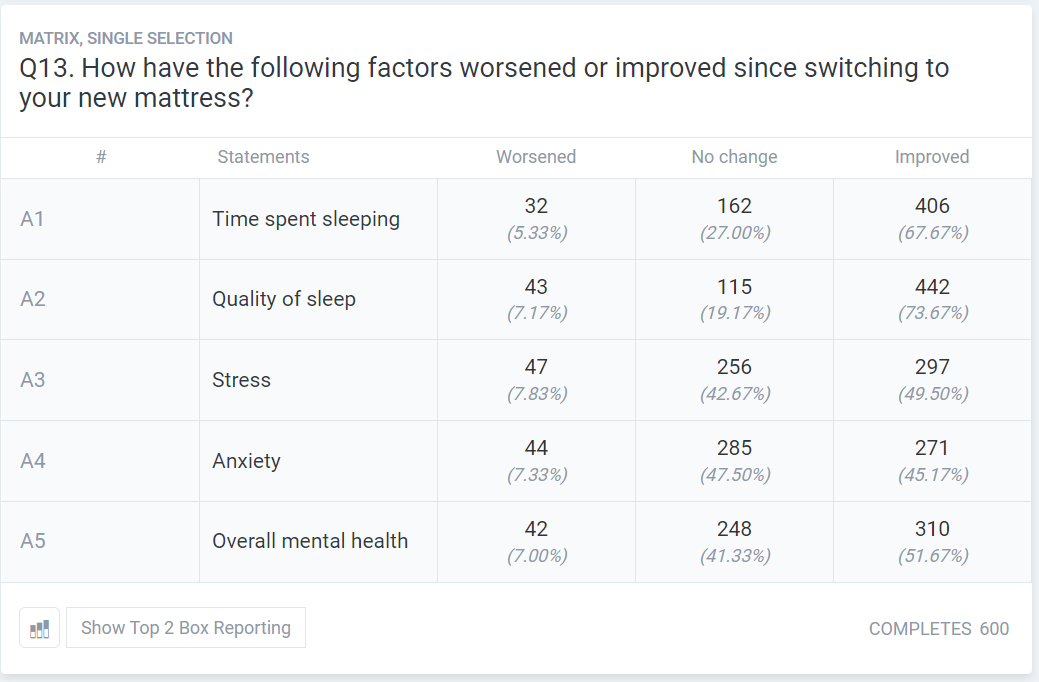If you’re among the one in three U.S. adults who are chronically sleep deprived, increasing the length and quality of your sleep could reduce anxiety, depression, mood swings, and poor concentration, while also strengthening your immune system. Finding a solution to poor sleep isn’t always straightforward, but improving your sleep hygiene is a good place to start. This might require you to change your sleep environment, like investing in a better bed, so you feel more comfortable throughout the night.
The Handbook Team surveyed people who recently bought sleep products to determine what’s helpful in improving sleep quality. We found that most survey respondents who recently purchased a mattress (80.5 percent) or an adjustable base (91.3 percent) reported improved sleep quality. More importantly, the majority of respondents (65.17 percent for mattresses and 72.6 percent for adjustable beds) also reported improved mental health as a result.
We also found that research supports the results we saw in our survey. For example, adjustable beds can assist in positioning and mobility. Studies show that elevating the head and chest can ease sleep apnea and acid reflux, while elevating the lower body may help ease chronic pain or swelling in the feet, legs, and lower back, leading to a more restful night’s sleep.
The effectiveness of an adjustable bed for pain relief can vary from person to person due to the origin of the pain. In my experience, people who have pain related to musculoskeletal conditions, such as back pain or arthritis, benefit most from an adjustable bed.
Amanda Weeks, an occupational therapist at B. Well Health in Philadelphia, Pennsylvania
Research also supports the impact mattress choice can have on sleep quality, and how it may even prevent conditions like lower back pain. Finding the right mattress that fits your sleep preferences and body type can help you maintain a consistently restful slumber.
Unfortunately, restful, elevated sleep can come at a price. The average queen-size adjustable bed or mattress retails for roughly $1,500 and $2,300, respectively. For that investment, the bed should be durable and comfortable and should come with excellent customer service. But the sleep industry is overwhelmingly large, and sleep is an individual experience. With so many options available, how do you know you’re investing in a product that will truly help your sleep quality and health?
To help you make an informed decision, we’ve made it our job to study, test, and review sleep products.
Why HelpGuide cares about a good night’s sleep



Quality sleep is a key part of mental health, physical health, and overall well-being. Sleep helps us to reset our bodies, process our emotions, and ease daily stress. Without it, we are at an increased risk of developing anxiety and depression, according to research.
But there are medical conditions that can make sleep difficult. Chronic pain, acid reflux, insomnia, and loud snoring or sleep apnea are issues that can keep you up at night, tossing and turning.
Finding solutions for better sleep can be frustrating, but we’re here to help. The HelpGuide Handbook Team wants to empower you to make the right decision by providing the most honest information about sleep-related products, like mattresses and adjustable beds.
Good sleep is essential for physical and mental health because it’s our body’s chance to recharge after the physical and cognitive loads of our day. When we sleep well, we have better relationships and communication with our partners, we can think more clearly, and we’re in a better mood.
Julia Catlin, licensed psychotherapist at Calm Science in Las Vegas.
In order to recommend the best options to fit your needs, we sought to better understand how sleep impacts overall health. We consulted with mental health experts, researchers, and industry leaders in sleep and ergonomics to connect the dots about what really matters in a mattress.
Ultimately, all of our research is directed at taking the stress out of finding the highest-quality products that can support your sleep health—and in turn, your overall mental well-being.
Who are we?
The Handbook Team is a group of writers, editors, designers, medical reviewers, and fact-checkers who have spent years perfecting the art of testing and reviewing health products.
We’ve spent more than 2,000 hours studying and testing sleep products. To date, we’ve interviewed more than 20 sleep specialists, psychologists, physical therapists, chiropractors, and occupational therapists about sleep science and read more than 100 scientific journal articles on the subject. We’ve also surveyed 1,200 people who bought mattresses and adjustable beds in the last five years, led our own focus groups, and read hundreds of user reviews.
After researching hundreds of adjustable bed and mattress models across the industry, we chose 28 adjustable bed models and 110 mattress models (and counting) to test and review hands-on.
What goes into our review process?
Professional insights
We conduct ongoing interviews with experts in psychology, sleep medicine, and physical and occupational therapy to understand the connection between pain, mental health, and sleep quality. These three variables are closely related. Taking care of your mental and physical health typically leads to better sleep, and getting better sleep can help reduce feelings of anxiety and pain perception while boosting your mood and increasing emotional resilience.
“The connection between sleep and pain is bidirectional. Chronic pain can disrupt sleep, and poor sleep quality can intensify pain perception,” says Ryan Sultan, medical director of Integrative Psych and a psychotherapist and research professor at Columbia University.
Sleep deprivation is strongly linked to an increased risk of developing mental health disorders such as depression and anxiety, and it can also worsen the symptoms of existing mental health conditions.
Rachel Ragsdale, founder and owner of Braincode Centers and board-certified in neurofeedback
Clearly, getting better sleep is an important part of healthy living. In some cases, improving the duration and quality of your sleep could be as simple as sleeping on an incline. We turned to our panel of professionals to understand how nighttime positional aids, like adjustable beds, can help.
If you have conditions like acid reflux, gastroesophageal reflux disease (GERD), heart failure, or obstructive sleep apnea, lying flat can cause discomfort and breathing difficulties. Sleeping in an inclined position improves comfort and sleep quality for individuals with these conditions.
Sarah Jeffries, an emergency care specialist located in the UK
Our testing experience
Adjustable bed research and testing
Surveys
To understand the long-term advantages and disadvantages of adjustable beds, we surveyed 600 Americans who had purchased an adjustable bed in the last five years. More than 91 percent of survey respondents believe their adjustable bed helps them sleep better, and 72 percent said it improves their mental health.

Custom settings are a popular option (second only to TV/reading settings), indicating that adjustable beds help people find a uniquely comfortable resting or sleeping position.

The survey results suggest that adjustable beds are somewhat durable, with one-third of respondents requiring repair or replacement while under warranty. Most of our survey respondents experienced no issues with their adjustable beds, but those who did said finding compatible sheets was their biggest concern.

We also asked about the buying process to understand where people tend to shop for adjustable beds, which brands interest them, and what features they prioritize. We used this information to test and compare the features that matter, like price, adjustable lumbar support, and preset positions.
Focus groups and personal interviews
We ran a focus group with adjustable bed users and conducted additional one-on-one ad hoc interviews. We wanted to know why people were interested in an adjustable bed, what kind of research they did during the buying process, why they chose a particular brand and model, how easy it was to set up, and whether they felt satisfied with their purchase.
I bought it for all these pain issues, and I knew that it would decrease the pain; I would sleep better. I just didn’t realize how much better I would sleep and how bad my sleep was before. I mean, my friends will literally tell you I’m a much nicer person now than I was before I got this bed.
Focus group participant
All of this information helped us step into the shoes of an adjustable bed buyer, allowing us to test the right features, ask salespeople the right questions, and research the most popular models. Most people had a positive experience with their adjustable bed and were glad they bought it.
I wish I would’ve done it sooner, honestly. It’s done nothing but improved my mental health, my sleep quality, my physical pain, and just all around general well-being.
Focus group participant
Mystery shopping
We began our mystery shopping experience online, noting whether each adjustable base company made it easy to compare models on their website. We contacted customer service through the chat portal to gauge response times and friendliness. We also went through the online ordering process to see how easily we could set up financing, installation, and haul-away services.
Our team also visited showrooms in two cities to gather information that can’t be found online. We pretended to shop for ourselves or our parents, so we didn’t get any special treatment as reviewers. Some sleep stores pay their salespeople on commission, which can translate to pushy sales tactics. We noted this behavior and other examples of poor customer service while visiting each showroom.
We also looked for major differences between what’s offered online versus in-store in terms of sales, discounts, return policies, and warranties to determine which shopping experience gives the most benefits.
From our tester
“The salesperson was ‘sticky’—she hovered and supervised me testing the bed. It was a bit awkward, but she wasn’t pushy. At the end, she offered me a 10 percent discount for shopping in-store.”
Hands-on testing
Although shopping online for an adjustable bed is convenient, it’s difficult to get a sense of the bed’s noise level, smooth operation, and general durability without trying it in person. But even that’s a tall order, because some brands offer a limited number of showrooms across the United States. Fortunately, visiting these locations isn’t a problem for the Handbook Team, as we’re spread across the country and can view major brands in person.
From our tester
“The Saatva Adjustable Base is louder than the Adjustable Base Plus. The sales rep explained that they use the same motor, but the Adjustable Base Plus has more padding around the base, which may transfer less sound.”
To date, we’ve traveled to 12 showrooms in New York City and Las Vegas and tested 28 adjustable bases. When possible, we collect quantifiable data, like noise level and incline time. We also evaluate ease of use, app or remote functionality, and massage features—things you can’t assess from a company’s website.

From our tester
“Both Tempur-Pedic bases reach a full incline in about 20 seconds, but they move much faster than other brands, like Casper, and reach a steeper incline. It sits all the way up to a comfortable sitting position. I could’ve stayed there watching TV or reading for a while—it was a good position for me.”
Adjustable bed testing experience
After arriving at a showroom and identifying the correct base, we followed these procedures:
- Gather first impressions: We looked for any indication that the base would be unstable, too heavy for do-it-yourself setup, or difficult to plug in.
- Test the remote or app: The best remotes used intuitive symbols and had buttons that were easy to press. If the bed used a smartphone app, we evaluated its navigation and features.
- Adjust the base: While lying on the bed, we timed how long it took for the base to move from a neutral to fully inclined position and noted how smooth or shaky this motion felt.
- Record decibel level: We adjusted the base from a neutral to fully inclined position and recorded the sound level using a decibel measuring app.
- Test presets: The best adjustable beds had useful and unique presets and offered an intuitive procedure for saving custom presets.
- Test massage: We noted whether the massage felt comfortable and relaxing, how many timing presets, modes, and intensities were available, and whether the entire bed vibrated or just one part of it.
- Test extra features: We tested and evaluated any additional features, like under-bed lighting.
- Evaluate delivery proposal: We spoke with salespeople about the delivery process and noted whether it seemed easier or more difficult than other brands. The best brands also offered installation services and same-day removal of the old base.
- Evaluate customer service: We preferred interacting with salespeople who were helpful but not pushy.
Mattress research and testing
Surveys
We surveyed 600 people who bought a mattress in the last three years to understand what impact their mattress had on their health and to determine what features or services are most valued.
More than 42 percent of respondents got a new mattress to improve their comfort and support for better sleep, while 18.2 percent simply needed to replace an old, worn bed. We also saw a variety of other reasons for switching mattresses, including pain relief, medical recommendations, and lifestyle changes (like moving homes).

Regardless of the reason for switching mattresses, more than 80 percent of respondents believe their new mattress helps them sleep better, and more than 65 percent attribute improved mental health to their new mattress. Once respondents committed to switching their mattress for a more suitable one, roughly 70 percent reported improved overall quality of sleep and time spent sleeping.

We found that price was the most important consideration when choosing a mattress. About 28 percent of respondents said their budget was $500–$1,000, while 30 percent said they’d be willing to spend more than $2,000. After cross-comparing these results with our focus group participants and trends according to industry leaders, we identified a pattern: People are either on a strict budget or are looking for luxury mattresses—the middle-road mattresses just aren’t as popular.
We also asked respondents about their sleep preferences and what features they prioritize. This helped us build our testing strategy and compare mattress characteristics that matter most, like composition, firmness, and pressure relief.
Focus groups
Our team ran a focus group with people who bought a new mattress within the past three years. We wanted to know about their purchase process: why they decided to make a change, what they deemed most important in a mattress, and how they made their final decision. We also wanted to know about their unique circumstances. Some participants preferred all-organic materials in their bedroom while others wanted a mattress that would accommodate a growing family.
I tried to sit on the edge of my bed to put my shoes on, and I literally fell off the mattress’s edge. So I thought, this is not for me. I need to do better than this
Focus group participant
The information we learned from the focus group participants helped us understand what features or qualities are most important to test. It also helped us understand obstacles in the purchase process and which services are most valuable, like trial periods or white glove delivery (delivery and setup of new mattress, and takeaway of old mattress).
It was a horrible experience moving my latex mattress. It was 150 pounds, and we had to carry it up the steps. We were completely sweating. It took forever, and we did get it set up, but it was just really uncomfortable.
Focus group participant
Mystery shopping
A majority of our mystery shopping involved online browsing and interacting with customer service. We noted whether brands were transparent about the quality of their materials, like showcasing a CertiPUR-US certification. We also determined if the brand clearly stated composition and firmness levels, since these were our survey respondents’ top two most important considerations.
Our team walked through the online purchase process to see how easy it was to adjust an order, like adding white glove delivery. Mattress brands offering models with multiple online firmness options earned points on our scorecard for their customizability. Brands also earned points if they had multiple ways to contact customer service, like a live chat or phone line available every day of the week.
Hands-on testing
The Handbook Team hand-tests mattresses in our studios located in North Carolina. We start our testing from the moment they’re delivered.
Some mattresses require unboxing, which is a lengthy step in the setup process. A mattress-in-a-box requires a day to decompress and sometimes off-gas. We make notes on how easy or difficult this process was for us so that you know what to expect, especially if the mattress setup takes longer than anticipated.

Then, our team puts the mattress’s materials, construction, and composition to the test. We compare its qualities to online descriptions to see how accurate they are and so you know what you’re getting. We also put it through tests that rate its sinkage, pressure relief, support, motion isolation, bounciness, edge support, and cooling.
And since most of us do more than sleep on our mattress, we developed a sex and family subscore to determine how well a mattress can support other aspects of our lives.
From our tester
I like how some mattresses are built for everyday life, not just sleeping. I imagine sitting with my spouse (and maybe a future kid or a pet) on the mattress one morning and feeling comfortable just hanging out. Not all mattresses are as comfortable for awake activities as they are for sleeping.
Mattress testing experience
For all our mattresses delivered in-house, we followed this list of procedures:
- Document the setup process: We set up the mattress by unboxing it, allowing it to decompress, and moving it to the bed frame (as applicable).
- Gather first impressions: We ensured the mattresses looked clean, with intact stitchwork. We also noted if there was a removable cover and how the cover felt to the touch.
- Evaluate firmness and sleep position compatibility: We lay on each mattress and determined its firmness based on feel, not based on the online description. We tried every sleep position to determine how well the mattress contoured to our body and supported our spine.
- Evaluate spinal support: After lying in different positions, we scored the mattress based on how well it reinforced our spine’s natural curves in a comfortable, neutral position.
- Visualize pressure relief: We used a pressure map to see how well the mattress redistributed high-pressure areas of our body, like the shoulder and hip, to make sleeping feel weightless.
- Test motion isolation: Using a seismograph, we determined how well the mattress isolated motion by rolling a 10-pound ball on the surface and analyzing the readings. Testers also measured how much motion transferred when changing positions, crawling, and bouncing on the opposite side of the bed.
- Document edge support: We sat on the edge of the mattress to determine how much it sank under our weight. We also lay by the edge to see if it felt secure.
- Test cooling: We determined how well the mattress dissipated body heat using a temperature gun. First, we used the gun to get the surface temperature. Next, two testers lay side-by-side for five minutes and documented the surface temperature after the time was up. The larger the temperature difference, the worse the score.
- Assess the sex score: While kneeling on the bed, we bounced on the mattress for several seconds to see how effortful rhythmic movement felt on the mattress surface. This was also a subscore based on bounce (50 percent), edge support (30 percent), and cooling (20 percent).
- Assess the family score: Three testers lay and sat on the mattress to determine how well the surface supported multiple people, like a couple and their toddler or pet. This was also a subscore based on support (30 percent), edge support (30 percent), motion transfer (20 percent), and cooling (20 percent).
Disclaimer
We acknowledge that every body is different, and what feels comfortable to one person may not feel comfortable to another. Throughout our roundups, we refer to weight categories as light (below 130 pounds), average (130–250 pounds), and heavy (above 250 pounds) to distinguish between body weights. These categories are based on industry standards.
Typically, lighter-weight sleepers perceive mattresses as firmer than they actually are, and higher-weight sleepers perceive mattresses as softer than they are. Keep in mind that most mattresses are designed for the average-weight person.
Our final verdict
Sleep products, like adjustable beds and mattresses, have the power to transform your physical and mental health, but they’re an expensive purchase that can be a hassle to return. You deserve to choose one based on unbiased and reliable information, which is why the Handbook Team only recommends products that meet our rigorous vetting and testing standards.
- Albaroqouni, L., Moynihan, R., Clark, J., Scott, A.M., Duggan, A. and Del Mar, C. (2021). Head of bed elevation to relieve gastroesophageal reflux symptoms: A systematic review. BMC Family Practice, 22(1), 24. Link
- Blaivas, A.J., Turley Jr., R., and Pierce-Smith, D. (n.d.). Sleep deprivation. Cedars Sinai. Link
- Caggiari, G., Talesa, G. R., Toro, G., Jannelli, E., Monteleone, G., & Puddu, L. (2021). What type of mattress should be chosen to avoid back pain and improve sleep quality? Review of the literature. Journal of Orthopaedics and Traumatology: Official Journal of the Italian Society of Orthopaedics and Traumatology, 22.
- Goldman, S.M. (2005). Nocturnal neuropathic pain in diabetic patients may be caused by spinal stenosis. Diabetic Medicine, 22(12), 1763-1765. Link
- Ratchford, E.V., and Evans, N.S. (2017). Approach to lower extremity edema. Current Treatment Options in Cardiovascular Medicine. 19(16). Link
- Scott, A.J., Webb, T.L., Martyn-St James, M., Rowse, G., & Weich, S. (2021). Improving sleep quality leads to better mental health: A meta-analysis of randomised controlled trials. Sleep Medicine Reviews, 60, 101556. Link
- Sleep and Sleep Disorders. (2022, September 7). Centers for Disease Control and Prevention. Link
- Souza, F.J., Genta, P.R., Filho, A.J., Wellman, A. and Lorenzi-Filho G. (2017). The influence of head-of-bed elevation in patients with obstructive sleep apnea. Sleep Breath. 21(4), 815-820. Link







